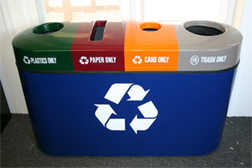Many businesses make an attempt at some type of recycling in their offices. But, no matter what you are doing at the office, more of an effort can be made. And it is simple. Even though Earth Month is drawing to a close, here are a few ideas on how you can do more Reducing, Reusing and Recycling at work.
Firstly, placing more recycling containers around the office will always help. Don’t just have one by the copy machine. Be sure there are recycling bins at each desk or at each cluster of desks. Perhaps add a dual stream recycling system in the employee break room so that everything can be recycled including glass, paper, aluminum and waste.
Recycling is important, but first and foremost: Use less whenever possible. And don't think you can't make a difference by recycling... recycling just one aluminum can saves the amount of energy required to run a TV for three hours! Here are a few suggestions that will help reduce our use of precious natural resources.
Many computers, monitors, cell phones and other electronics include toxic materials that should not sit in landfills, and you'd be surprised how many retailers and other companies will take your old gadgets for recycling. The Environmental Protection Agency (link: http://www.epa.gov/) will help you find local electronics recyclers.
Say no to junk mail - 100 million trees' worth are sent out each year. Visit www.dmachoice.org/MPS/ to opt out of the Direct Marketing Association's member mailings.
Packing peanuts and other loose fill will sit in a landfill for centuries, but there are lots of places you can bring them for recycling. Call the Peanut Hotline at 1-800-828-2214.
If every household in the US replaced 1 roll of 1000 sheet bathroom tissues with 100% recyclable rolls, we could save 373,000 trees, 1.48 million cubic feet of landfill space, and 155 million gallons of water.
For more information on recycling bins for your office, contact the Fibrex Group.
greenlivingapartments.com


































 With different rules and recycling services for each city, it can be difficult to have a firm grasp on what exactly is recyclable and what’s not. Even the most environmentally conscious folks stop short when it comes to disposing of certain food containers. It sounds right to be safe rather than sorry by just throwing that item we’re not sure about in the recycling. However, it turns out that this method of thinking is causing more harm than good.
With different rules and recycling services for each city, it can be difficult to have a firm grasp on what exactly is recyclable and what’s not. Even the most environmentally conscious folks stop short when it comes to disposing of certain food containers. It sounds right to be safe rather than sorry by just throwing that item we’re not sure about in the recycling. However, it turns out that this method of thinking is causing more harm than good. 




